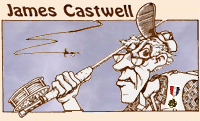|
I am going to quote directly from something in a
current magazine. It is pointless to say where
this is from, but it will serve to illustrate.
"You know, it seems like every year each manufacturer
comes out with twenty models of rods and in spite of
what they tell you, there is really nothing different
about the models that were out the previous year."
"No there isn't, the materials are the same, they
just copyright another name for them."
So there it is. A segment of our population thinks
or feels somewhat that the rod makers are screwing
us with hype. That they shift rods around and rename
them, change the colors, but nothing is really new.
For a fact, I know of none who do or have done that.
Not to say it may not have been done, but it would
not be a wise idea. There was a company that came
out with a rod with a slug in the tip for some reason,
the next model they moved the weight down to the handle.
One of these had to be wrong. There was lots of hype
involved in that one, but it was new.
It is claimed that all of the rod makers are
trying to make faster rods. Not true, if by
faster you mean stiffer. The aim is to make
rods which weigh less in hand, are slimmer
and for the most part fish a line at all
reasonable distances. Yes, many do make
speciality rods, but that is not the point
of this column. The makers are working day
and night to out do each other with the best
possible fishing rods. Competition demands it.
Think about it for a minute, some of the variables;
I.D., O.D., actual thickness of the wall, interior
taper, exterior taper, the cloth elements used, the
materials on each, the direction of the weave of the
cloth, the thickness of the cloth and the number of
the wraps needed. These are just a few of the basics.
There are more. Change even one of these and you have
a different rod.
Hard to figure they would claim a new rod when it
is so easy to actually have one. Add some boron,
graphite, ceramic; another new rod. Sure they will
advertise the rod and I am sure is better in some
way than the generation before it. Not much point
of making it if not.
So, let's say they have finally invented a great rod.
Then a new material becomes available, a newer
graphite/ceramic/bubble gum. Wait until the competition
tries it? Or comes out with it? Right, fire up the old
R&D and see what the stuff can do?
It seems that a winning design will last for about
five years, a not so great one much less than that.
Sometimes a small tweak can be a covered by adding a
'+' to the rod number or a letter or two. For rather
obvious reasons complete model ranges are invented,
discontinued and replaced in the companies rod line.
I have been fortunate to have known some of the top
rod makers over the years. Their job hangs on
improving rods for better sales. The more people
who like the rods the more they sell. Pretty simple.
These guys eat, sleep and live rods and rod design.
They love it; they better, they have to. ~ James Castwell
|

